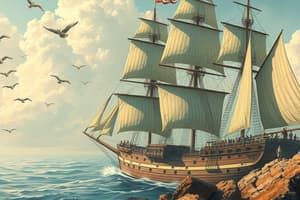Podcast
Questions and Answers
What was Charles Darwin's role on the HMS Beagle?
What was Charles Darwin's role on the HMS Beagle?
- Captain of the ship
- Naturalist and companion to the Captain (correct)
- Ship's doctor
- Navigator
What was notable about the fossils Darwin found in South America?
What was notable about the fossils Darwin found in South America?
- They were identical to modern species
- They were similar to, but distinct from, modern species (correct)
- They were identical to species found in other regions
- They were not similar to any known species
What did Darwin observe about species on the Galapagos Islands?
What did Darwin observe about species on the Galapagos Islands?
- They were all extinct
- They were all identical
- They varied in characteristics such as beak shape and size (correct)
- They were all distinct from each other
What did Darwin conclude about the Earth's surface through his geological observations?
What did Darwin conclude about the Earth's surface through his geological observations?
How did species adapt to their environments, according to Darwin's observations?
How did species adapt to their environments, according to Darwin's observations?
What was the significance of Darwin's observations on the HMS Beagle?
What was the significance of Darwin's observations on the HMS Beagle?
Flashcards are hidden until you start studying
Study Notes
Voyage of the Beagle
- 1831-1836: Charles Darwin embarked on a 5-year voyage aboard the HMS Beagle, serving as a naturalist and companion to Captain Robert FitzRoy.
- Visited South America, Galapagos Islands, and other locations, collecting numerous specimens and making observations.
Key Observations
Fossil Record
- Found fossils of giant extinct species, such as Megatherium, in South America.
- Realized that these fossils were similar to, but distinct from, modern species in the same region.
Species Variation
- Observed variations in species across different regions, such as:
- Finches on the Galapagos Islands, with distinct beak shapes and sizes.
- Tortoises with distinct shell shapes and sizes.
Geological Uniformitarianism
- Observed geological formations and processes, such as:
- Erosion and deposition of rocks.
- Formation of coral reefs and atolls.
- Concluded that the Earth's surface had changed over time through gradual, uniform processes.
Adaptation to Environment
- Observed how species adapted to their environments, such as:
- Finches with strong beaks to crack open nuts.
- Tortoises with long necks to reach high branches.
Significance of Observations
- Darwin's observations laid the foundation for his theory of evolution through natural selection.
- Challenged the prevailing views of creationism and the fixity of species.
- Provided evidence for the idea that species change over time through adaptation to their environments.
Voyage of the Beagle
- Charles Darwin embarked on a 5-year voyage aboard the HMS Beagle, serving as a naturalist and companion to Captain Robert FitzRoy, from 1831 to 1836.
- Visited South America, Galapagos Islands, and other locations, collecting specimens and making observations.
Fossil Record
- Found fossils of giant extinct species, such as Megatherium, in South America.
- Fossils were similar to, but distinct from, modern species in the same region.
Species Variation
- Observed variations in species across different regions, including:
- Finches on the Galapagos Islands, with distinct beak shapes and sizes.
- Tortoises with distinct shell shapes and sizes.
Geological Uniformitarianism
- Observed geological formations and processes, including:
- Erosion and deposition of rocks.
- Formation of coral reefs and atolls.
- Concluded that the Earth's surface had changed over time through gradual, uniform processes.
Adaptation to Environment
- Observed how species adapted to their environments, including:
- Finches with strong beaks to crack open nuts.
- Tortoises with long necks to reach high branches.
Significance of Observations
- Darwin's observations laid the foundation for his theory of evolution through natural selection.
- Challenged the prevailing views of creationism and the fixity of species.
- Provided evidence for the idea that species change over time through adaptation to their environments.
Studying That Suits You
Use AI to generate personalized quizzes and flashcards to suit your learning preferences.




